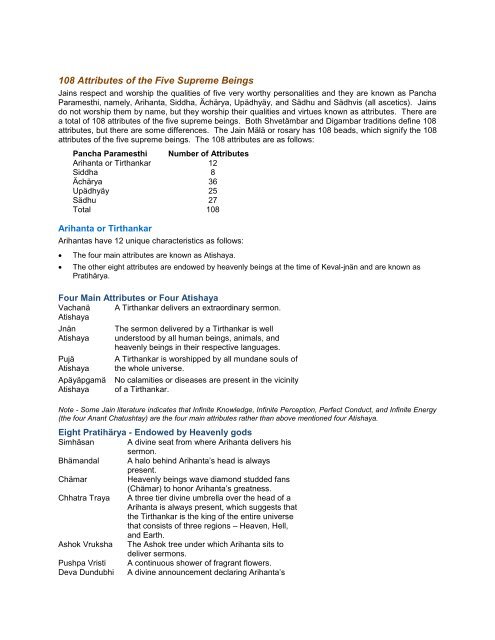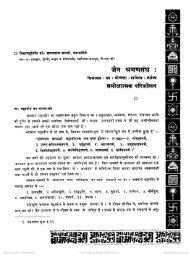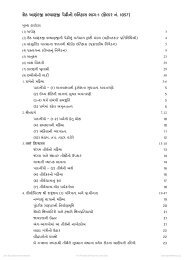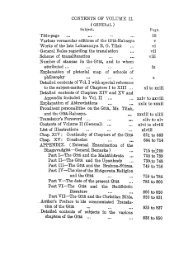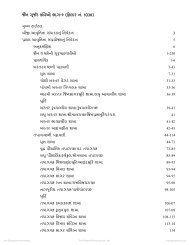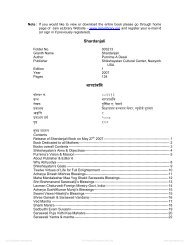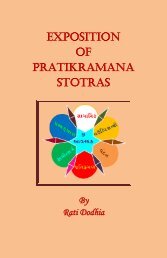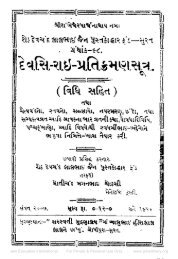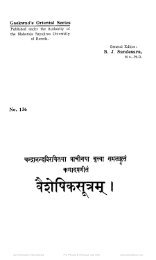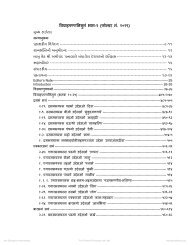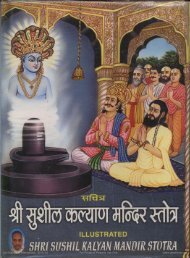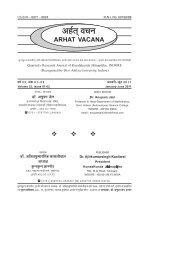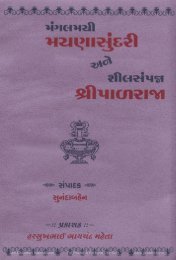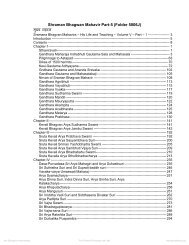108 Attributes of the Five Supreme Beings - Jain Library
108 Attributes of the Five Supreme Beings - Jain Library
108 Attributes of the Five Supreme Beings - Jain Library
Create successful ePaper yourself
Turn your PDF publications into a flip-book with our unique Google optimized e-Paper software.
<strong>108</strong> <strong>Attributes</strong> <strong>of</strong> <strong>the</strong> <strong>Five</strong> <strong>Supreme</strong> <strong>Beings</strong><br />
<strong>Jain</strong>s respect and worship <strong>the</strong> qualities <strong>of</strong> five very worthy personalities and <strong>the</strong>y are known as Pancha<br />
Paramesthi, namely, Arihanta, Siddha, Ächärya, Upädhyäy, and Sädhu and Sädhvis (all ascetics). <strong>Jain</strong>s<br />
do not worship <strong>the</strong>m by name, but <strong>the</strong>y worship <strong>the</strong>ir qualities and virtues known as attributes. There are<br />
a total <strong>of</strong> <strong>108</strong> attributes <strong>of</strong> <strong>the</strong> five supreme beings. Both Shvetämbar and Digambar traditions define <strong>108</strong><br />
attributes, but <strong>the</strong>re are some differences. The <strong>Jain</strong> Mälä or rosary has <strong>108</strong> beads, which signify <strong>the</strong> <strong>108</strong><br />
attributes <strong>of</strong> <strong>the</strong> five supreme beings. The <strong>108</strong> attributes are as follows:<br />
Pancha Paramesthi Number <strong>of</strong> <strong>Attributes</strong><br />
Arihanta or Tirthankar 12<br />
Siddha 8<br />
Ächärya 36<br />
Upädhyäy 25<br />
Sädhu 27<br />
Total <strong>108</strong><br />
Arihanta or Tirthankar<br />
Arihantas have 12 unique characteristics as follows:<br />
<br />
<br />
The four main attributes are known as Atishaya.<br />
The o<strong>the</strong>r eight attributes are endowed by heavenly beings at <strong>the</strong> time <strong>of</strong> Keval-jnän and are known as<br />
Pratihärya.<br />
Four Main <strong>Attributes</strong> or Four Atishaya<br />
Vachanä A Tirthankar delivers an extraordinary sermon.<br />
Atishaya<br />
Jnän<br />
Atishaya<br />
Pujä<br />
Atishaya<br />
Apäyäpgamä<br />
Atishaya<br />
The sermon delivered by a Tirthankar is well<br />
understood by all human beings, animals, and<br />
heavenly beings in <strong>the</strong>ir respective languages.<br />
A Tirthankar is worshipped by all mundane souls <strong>of</strong><br />
<strong>the</strong> whole universe.<br />
No calamities or diseases are present in <strong>the</strong> vicinity<br />
<strong>of</strong> a Tirthankar.<br />
Note - Some <strong>Jain</strong> literature indicates that Infinite Knowledge, Infinite Perception, Perfect Conduct, and Infinite Energy<br />
(<strong>the</strong> four Anant Chatushtay) are <strong>the</strong> four main attributes ra<strong>the</strong>r than above mentioned four Atishaya.<br />
Eight Pratihärya - Endowed by Heavenly gods<br />
Simhäsan A divine seat from where Arihanta delivers his<br />
sermon.<br />
Bhämandal A halo behind Arihanta’s head is always<br />
present.<br />
Chämar<br />
Heavenly beings wave diamond studded fans<br />
(Chämar) to honor Arihanta’s greatness.<br />
Chhatra Traya A three tier divine umbrella over <strong>the</strong> head <strong>of</strong> a<br />
Arihanta is always present, which suggests that<br />
<strong>the</strong> Tirthankar is <strong>the</strong> king <strong>of</strong> <strong>the</strong> entire universe<br />
that consists <strong>of</strong> three regions – Heaven, Hell,<br />
and Earth.<br />
Ashok Vruksha The Ashok tree under which Arihanta sits to<br />
deliver sermons.<br />
Pushpa Vristi A continuous shower <strong>of</strong> fragrant flowers.<br />
Deva Dundubhi A divine announcement declaring Arihanta’s
Divya Dhvani<br />
sermons.<br />
Celestial music accompanying Arihanta’s<br />
sermon.<br />
Some <strong>Jain</strong> literature expands <strong>the</strong> above 12 attributes to 34 attributes <strong>of</strong> Tirthankars also known as 34<br />
Atishaya. Some differences exist between <strong>the</strong> Shvetämbar and Digambar traditions in defining <strong>the</strong>se<br />
Atishayas.<br />
34 Atishaya <strong>of</strong> a Tirthankar - Shvetämbar Tradition:<br />
4 <strong>Attributes</strong> Present at Birth:<br />
Divine and healthy body, which is fragrant and without perspiration<br />
<br />
<br />
<br />
Fragrant breath<br />
Milky white, odorless blood and flesh<br />
Invisible food intake (diet) and excreta<br />
11 <strong>Attributes</strong> attained at Omniscience or Keval-Jnäna:<br />
Eight attributes indicating absence <strong>of</strong> disease, enmity, calamity, plague, flooding, draught, famine, and<br />
political unrest up to a distance <strong>of</strong> 125 Yojan (ancient degree <strong>of</strong> measurement 1 Yogan = approximately 4<br />
miles).<br />
<br />
<br />
<br />
The Tirthankar’s sermon, though delivered in Ardha-Mägadhi language, is understood well by all, including<br />
animals, and is heard clearly up to 1 Yojan away.<br />
Aura or Halo (Bhämandal) – A circle <strong>of</strong> light around Tirthankar’s head.<br />
A total <strong>of</strong> 10,000,000 x 10,000,000 (=100,000 billion) human beings, heavenly beings, and animals can be<br />
accommodated within a space <strong>of</strong> 1 Yojan Square when a Tirthankar delivers sermons.<br />
19 <strong>Attributes</strong> Created by Heavenly Gods:<br />
Wheel <strong>of</strong> dharma (Dharma-chakra) that moves with Tirthankar<br />
<br />
<br />
<br />
<br />
<br />
<br />
<br />
<br />
<br />
<br />
<br />
<br />
<br />
<br />
<br />
<br />
<br />
<br />
Chämar<br />
A throne<br />
Three layered umbrella over <strong>the</strong> head <strong>of</strong> Tirthankar<br />
A flag (Dharma-Dhajä)<br />
Nine golden lotus flowers to walk upon<br />
A gold, silver, and jewel-laden fort (Samavasaran) for delivering sermons<br />
Visibility <strong>of</strong> Tirthankar’s face from all directions while delivering sermons<br />
Ashok tree<br />
Thorns face downwards while Arihant is walking<br />
Trees bow down to Tirthankar<br />
Music from divine drums at <strong>the</strong> time <strong>of</strong> sermons<br />
Cool soothing breeze<br />
Circumambulation <strong>of</strong> birds<br />
Sprinkles <strong>of</strong> fragrant water<br />
Shower <strong>of</strong> fragrant flowers<br />
Hair and nails do not grow following renunciation<br />
Ten million heavenly beings always accompany Tirthankar<br />
The seasons are always favorable
34 attributes <strong>of</strong> Tirthankar - Digambar Tradition<br />
10 attributes present at birth:<br />
Most beautiful body<br />
<br />
<br />
<br />
<br />
<br />
<br />
<br />
<br />
<br />
Body full <strong>of</strong> fragrance<br />
Body devoid <strong>of</strong> perspiration<br />
Body devoid <strong>of</strong> excretion<br />
Peaceful and soothing voice<br />
Unmatched physical strength<br />
Milk-like blood<br />
1008 desirable birthmarks and features<br />
Proportionally built body<br />
Solid physique<br />
10 attributes acquired upon attaining omniscience:<br />
Prosperity exists all around in <strong>the</strong> presence <strong>of</strong> Arihanta<br />
<br />
<br />
<br />
<br />
<br />
<br />
<br />
<br />
<br />
Walking without touching <strong>the</strong> ground<br />
Visibility <strong>of</strong> Arihanta’s face from all four directions<br />
Total compassion<br />
Life devoid <strong>of</strong> obstacles<br />
No food required to sustain life<br />
Perfect knowledge<br />
No growth <strong>of</strong> hair and nails<br />
No blinking <strong>of</strong> eyes<br />
No formation <strong>of</strong> a shadow <strong>of</strong> body<br />
14 <strong>Attributes</strong> Created by <strong>the</strong> Heavenly Gods:<br />
Facilitating a universal language<br />
<br />
<br />
<br />
<br />
<br />
<br />
<br />
<br />
<br />
<br />
<br />
<br />
<br />
Enabling all beings to get along with each o<strong>the</strong>r<br />
Clean air all around<br />
Clear skies<br />
Fruits, crops, and flowers flourish year-round irrespective <strong>of</strong> season<br />
Miles and miles <strong>of</strong> neat and clean grounds all-around<br />
Lotuses made from gold under Tirthankar’s feet<br />
Sounds <strong>of</strong> reverential praises in <strong>the</strong> skies around Tirthankar<br />
Blowing <strong>of</strong> slow and fragrant breeze<br />
Fragrant rain<br />
Removal <strong>of</strong> all potential obstacles from <strong>the</strong> land<br />
Contentment all around<br />
Movement <strong>of</strong> <strong>the</strong> Dharma-chakra (symbolic wheel <strong>of</strong> religion) in Tirthankar’s Samavasaran<br />
Presence <strong>of</strong> eight embellishments; Chhatra, Chämar, Dhajä (flag), bell, Kalash (sacred vessel), fan,<br />
swastika, and mirror around <strong>the</strong> Tirthankar
Siddha<br />
Siddhas are liberated souls. They are no longer among us because <strong>the</strong>y have completely ended <strong>the</strong><br />
cycle <strong>of</strong> birth and death. They have destroyed all <strong>the</strong>ir Karma, and <strong>the</strong>y do not acquire any new karma.<br />
This state <strong>of</strong> true freedom is called liberation. By destroying all 8 types <strong>of</strong> Karmas, Siddhas manifest 8<br />
unique attributes as follows:<br />
Eight <strong>Attributes</strong> <strong>of</strong> Siddhas<br />
<strong>Attributes</strong> Meaning Name <strong>of</strong> Karma<br />
4 <strong>Attributes</strong> by destroying Four Ghäti Karma<br />
Anant-jnän Infinite knowledge Jnänävaraniya<br />
Karma<br />
Anant-darshan Infinite perception Darshanävaraniya<br />
Karma<br />
Anant-chäritra Perfect conduct Mohaniya Karma<br />
Anant-virya Infinite energy Antaräya Karma<br />
4 <strong>Attributes</strong> by destroying Four Aghäti Karma<br />
Avyäbädhasukha<br />
Eternal happiness Vedaniya Karma<br />
Akshaya-Sthiti Immortality Äyushya Karma<br />
Arupitva Formlessness Näma Karma<br />
Aguru-Laghutva Equality among all Gotra Karma<br />
Siddhas<br />
Ächärya<br />
The teachings <strong>of</strong> Lord Mahävir are carried on by <strong>the</strong> Ächäryas. They are <strong>the</strong> spiritual leaders and <strong>the</strong><br />
heads <strong>of</strong> <strong>the</strong> congregation <strong>of</strong> monks, nuns and lay people. They possess <strong>the</strong> following 36 qualities:<br />
Thirty Six <strong>Attributes</strong> <strong>of</strong> Ächäryas - Shvetämbar Tradition<br />
18 <strong>Attributes</strong> with regards to elimination <strong>of</strong> 18 Impurities<br />
5 <strong>Attributes</strong> <strong>of</strong> self-control over <strong>the</strong> pleasures <strong>of</strong> <strong>the</strong> 5 senses<br />
Touch, Taste, Smell, Sight, and Hearing<br />
<br />
9 <strong>Attributes</strong> to follow 9 restrictions for observance <strong>of</strong> celibacy<br />
Not to live where lay people (Shrävaks and Shrävikäs) live<br />
Not to sit alone with a person <strong>of</strong> <strong>the</strong> opposite gender<br />
Not to talk in private with a person <strong>of</strong> <strong>the</strong> opposite gender<br />
Not to observe <strong>the</strong> body <strong>of</strong> <strong>the</strong> opposite gender<br />
To only eat bland but pure food (not dressed with spices)<br />
To avoid food that produces impurity <strong>of</strong> <strong>the</strong> mind<br />
Not to adorn <strong>the</strong> body<br />
Not to remember past sensual pleasures<br />
Not to listen to <strong>the</strong> private conversations <strong>of</strong> o<strong>the</strong>rs<br />
4 <strong>Attributes</strong> to avoid <strong>the</strong> 4 types <strong>of</strong> passions<br />
Anger, Ego, Deceit and Greed<br />
18 <strong>Attributes</strong> with regards to 18 Qualities to Acquire<br />
5 <strong>Attributes</strong> pertaining to follow <strong>the</strong> <strong>Five</strong> Great vows<br />
<br />
Nonviolence, Truthfulness, Non-stealing, Celibacy, Non-possessiveness / Non-possession<br />
5 <strong>Attributes</strong> related to observe <strong>the</strong> five codes <strong>of</strong> conduct regarding<br />
Knowledge, Faith, Conduct, Penance, Vigor
5 <strong>Attributes</strong> related to observing carefulness<br />
Walking, talking, obtaining alms, putting clo<strong>the</strong>s and o<strong>the</strong>r things and disposing bodily waste<br />
properly<br />
3 <strong>Attributes</strong> to restrain <strong>the</strong> three medium <strong>of</strong> activity<br />
Regarding activities <strong>of</strong> mind, speech and body<br />
Thirty Six <strong>Attributes</strong> <strong>of</strong> Ächäryas - Digambar Tradition<br />
Digambar tradition, however, mentions thirty-six attributes <strong>of</strong> Ächäryas as follows:<br />
6 External Austerities<br />
<br />
<br />
<br />
<br />
Anashan (Not eating for a set period <strong>of</strong> time)<br />
Unodari (Eating less than needed)<br />
Vritti-sankshepa (Eating within <strong>the</strong> limits <strong>of</strong> predetermined restrictions)<br />
Material - Eat only a certain number <strong>of</strong> items<br />
Area - Eat only within limits <strong>of</strong> a certain area<br />
Time - Eat only once at a certain time<br />
Mode - Eat food only obtained or made by certain means<br />
Rasa Tyäg (Eating non-tasty food (reflection <strong>of</strong> temptation – example; Äyambil Tapa)<br />
Käya-klesha (Penance, tolerating physical pain voluntarily)<br />
Sanlinatä (Staying in a forlorn place and occupying minimum space)<br />
6 Internal austerities<br />
Präyashchitta (Repentance or remorse)<br />
Vinay (Humility, Respect for o<strong>the</strong>rs)<br />
Veyävachcham (Selfless service to monks, nuns and needy)<br />
Swädhyäy (Study <strong>of</strong> religious scriptures)<br />
Dhyäna (Meditation)<br />
Käyotsarga (Giving up physical activities and staying absorbed in <strong>the</strong> soul)<br />
10 Religious Virtues<br />
Kshamä (Forgiveness)<br />
Märdava (Humility)<br />
Ärjava (Straightforwardness)<br />
Shaucha (Contentment - absence <strong>of</strong> greed)<br />
Satya (Truth)<br />
Sanyam (Self-control)<br />
Tapa (Austerities)<br />
Tyäg (Renunciation)<br />
Äkinchan (Non-possessiveness)<br />
Brahmacharya (Celibacy)<br />
5 Ächär (Codes <strong>of</strong> Conduct)<br />
Darshanächär (Codes <strong>of</strong> Acquiring Right Perception)<br />
Jnänächär (Codes <strong>of</strong> Acquiring Right Knowledge)<br />
Chäriträchär (Codes <strong>of</strong> Acquiring Right Conduct)<br />
Tapächär (Codes <strong>of</strong> Austerities)<br />
Viryächär (Codes <strong>of</strong> Exercising Energy or Vigor)<br />
6 Ävashyaks (Essential Duties)<br />
Devapujä (Prayer to Tirthankars)
Gurupästi (Devotion and service to Gurus)<br />
Swädhyäy (Studying <strong>of</strong> Scriptures)<br />
Sanyam (Self restraints)<br />
Tapa (Penance)<br />
Däna (Imparting Knowledge and Protection <strong>of</strong> Life)<br />
3 Guptis (Control)<br />
Mano Gupti (Control over mind)<br />
Vachan Gupti (Control over speech)<br />
Käya Gupti (Control over body)<br />
Upädhyäy<br />
This title is given to those Sädhus who have acquired complete knowledge <strong>of</strong> <strong>the</strong> <strong>Jain</strong> scriptures (Ägams)<br />
and philosophy. They teach <strong>Jain</strong> scriptures to o<strong>the</strong>r ascetics and lay people. Upädhyäys possess 25<br />
attributes. These 25 attributes are <strong>the</strong> symbolic representation <strong>of</strong> <strong>the</strong> 25 <strong>Jain</strong> scriptures <strong>the</strong>y study.<br />
These scriptures are as follows:<br />
Twenty <strong>Five</strong> <strong>Attributes</strong> – Shvetämbar Tradition<br />
11 canonical texts (Anga Ägam) compiled by <strong>the</strong> Ganadharas, who were <strong>the</strong> immediate/first disciples <strong>of</strong><br />
Tirthankar<br />
<br />
<br />
12 canonical texts (Upängas) compiled by Shruta Kevalis<br />
1 scripture <strong>of</strong> proper conduct<br />
1 scripture <strong>of</strong> proper practice<br />
Twenty <strong>Five</strong> <strong>Attributes</strong> – Digambar Tradition<br />
11 Canonical texts (Anga Ägam) compiled by <strong>the</strong> Ganadharas (same for all <strong>Jain</strong> sects)<br />
14 Purva Ägam (Oldest <strong>Jain</strong> scriptures) compiled by <strong>the</strong> Ganadharas (same for all <strong>Jain</strong> sects)<br />
Sädhu and Sädhvi<br />
<strong>Jain</strong> literature defines 27 attributes <strong>of</strong> ascetics. Both Digambar and Shvetämbar traditions have some<br />
differences in defining <strong>the</strong>se attributes. Also, <strong>the</strong> Shvetämbar literature defines two groups <strong>of</strong> 27<br />
attributes.<br />
When lay people (Shrävaks and Shrävikäs) wish to detach from <strong>the</strong> worldly aspects <strong>of</strong> life and gain a<br />
desire for spiritual upliftment, <strong>the</strong>y renounce <strong>the</strong>ir worldly lives and become Sädhus (monks) or Sädhvis<br />
(nuns). They must follow <strong>the</strong> five great vows known as five Mahävratas<br />
The great vows <strong>of</strong> monks and nuns imply not doing, not asking someone to do, and not appreciating<br />
someone’s act <strong>of</strong> breaching <strong>of</strong> <strong>the</strong>se vows by mind, body or speech.<br />
5 Mahävratas (Great Vows)<br />
Ahimsa Nonviolence Not to commit any type <strong>of</strong><br />
violence.<br />
Satya Truth Not to indulge in any type <strong>of</strong><br />
lie or falsehood<br />
Asteya Non-stealing Not to take anything not<br />
given voluntarily.<br />
Brahmacharya Celibacy Not to indulge in any<br />
sensual pleasures<br />
Aparigraha<br />
Nonpossessiveness<br />
Not to acquire more than<br />
what is needed to maintain<br />
day-to-day life
27 <strong>Attributes</strong> <strong>of</strong> Ascetics<br />
Shvetämbar Tradition (group 1)<br />
5 Great vows to follow<br />
<br />
<br />
<br />
<br />
<br />
<br />
<br />
<br />
<br />
<br />
5 senses to control – To control <strong>the</strong> pleasures <strong>of</strong> five senses; touch, taste, smell, sight, hearing<br />
3 activities to control: mind, speech, and body (Three Guptis)<br />
6 types <strong>of</strong> souls to protect<br />
Protection <strong>of</strong> five one-sensed lives (water, fire, earth, air and plant known as Sthävar souls) and<br />
one group <strong>of</strong> mobile living beings (two-sensed to five-sensed living beings grouped toge<strong>the</strong>r<br />
known as Trasa souls)<br />
Observe restraints<br />
Not to eat before sunrise or after sunset<br />
Practice forgiveness<br />
Avoid greed<br />
Endurance <strong>of</strong> hardship<br />
Endurance <strong>of</strong> suffering<br />
Introspection<br />
Keep a pure heart<br />
Shvetämbar Tradition (group 2)<br />
5 Great Vows (Mahä-vrata) to follow<br />
<br />
<br />
<br />
<br />
<br />
<br />
<br />
<br />
5 senses to control – To control <strong>the</strong> pleasures <strong>of</strong> five senses; touch, taste, smell, sight, hearing<br />
3 activies to control: mind, speech and body (three Guptis)<br />
4 Kashäyas to avoid, which are <strong>the</strong> four passions: Anger, Ego, Deceit, Greed<br />
3 attributes related to following <strong>the</strong> proper conviction or faith, knowledge, and conduct (Darshan, Jnän, and<br />
Chäritra)<br />
2 types <strong>of</strong> dhyäna to Practice - which are Dharma dhyäna and Shukla dhyäna.<br />
5 Activities and Regulations to Practice (5 Karan)<br />
Practice <strong>of</strong> yoga<br />
Practice total forgiveness<br />
Disinterest in worldly affairs and interest only in removal <strong>of</strong> Mithyätva and Kashäya (Interest in liberation -<br />
Samvega)<br />
<br />
<br />
Enduring hardships and suffering with equanimity known as conquering <strong>of</strong> Parishaha<br />
Endurance and fearlessness towards death and associated pains, and also acceptance <strong>of</strong> voluntary death<br />
known as Sanlekhanä<br />
Twenty Seven <strong>Attributes</strong> <strong>of</strong> Ascetics<br />
Digambar Tradition<br />
<strong>Attributes</strong> <strong>of</strong> <strong>the</strong> Digambar monks (Sädhus) vary somewhat, with one significant requirement that male<br />
monks are sky-clad, or do not wear any clothing.<br />
<br />
<br />
<br />
<br />
5 Great Vows Mahä-vrata<br />
5 Samiti<br />
Iryä Samiti (carefulness while walking)<br />
Bhäshä Samiti (carefulness in talking)<br />
Eshanä Samiti (carefulness while receiving alms)<br />
Ädäna Nikshepanä Samiti (carefulness while handling clo<strong>the</strong>s or any object)<br />
Pärishthä-pänikä Samiti (carefulness while disposing <strong>of</strong> bodily waste)<br />
5 senses to control – To control <strong>the</strong> pleasures <strong>of</strong> five senses; touch, taste, smell, sight, hearing<br />
6 Ävashyaks (Essential Duties - same as in Digambar Ächäryas)
Devapujä (Prayer to Tirthankars)<br />
Gurupästi (Devotion and service to Gurus)<br />
Swädhyäy (Study <strong>of</strong> Scriptures)<br />
Sanyam (Self restraint)<br />
Tapa (Penance)<br />
Däna (Imparting Knowledge and Protection <strong>of</strong> Life)<br />
<br />
6 O<strong>the</strong>r <strong>Attributes</strong><br />
Kesha-lochan (Plucking <strong>of</strong> own hair)<br />
Asnäna (No bathing)<br />
Bhumi Shayan (Sleeping on <strong>the</strong> floor)<br />
Adanta-dhovan (No brushing <strong>of</strong> teeth)<br />
Uttisthan-ähär Sevan (Eating food in standing posture)<br />
Ekabhukti (Eating one meal a day only)<br />
Some schools maintain monks (not nuns) wearing no clo<strong>the</strong>s, as an attribute in this section. According to<br />
<strong>the</strong>m monks have twenty-eight attributes instead <strong>of</strong> twenty-seven.<br />
The <strong>Jain</strong> ascetics possess <strong>the</strong> above attributes. Their activities are directed towards <strong>the</strong> upliftment <strong>of</strong><br />
<strong>the</strong>ir souls to <strong>the</strong> state <strong>of</strong> liberation.<br />
Pravin K Shah<br />
<strong>Jain</strong>a Education Committee<br />
jainaedu@gmail.com<br />
www.jainelibrary.org<br />
919-859-4994


